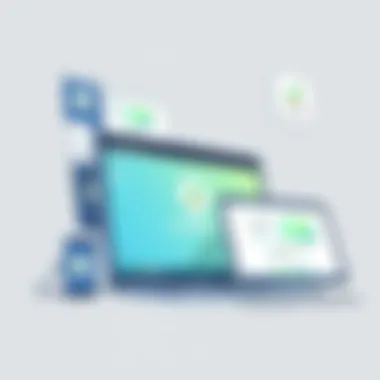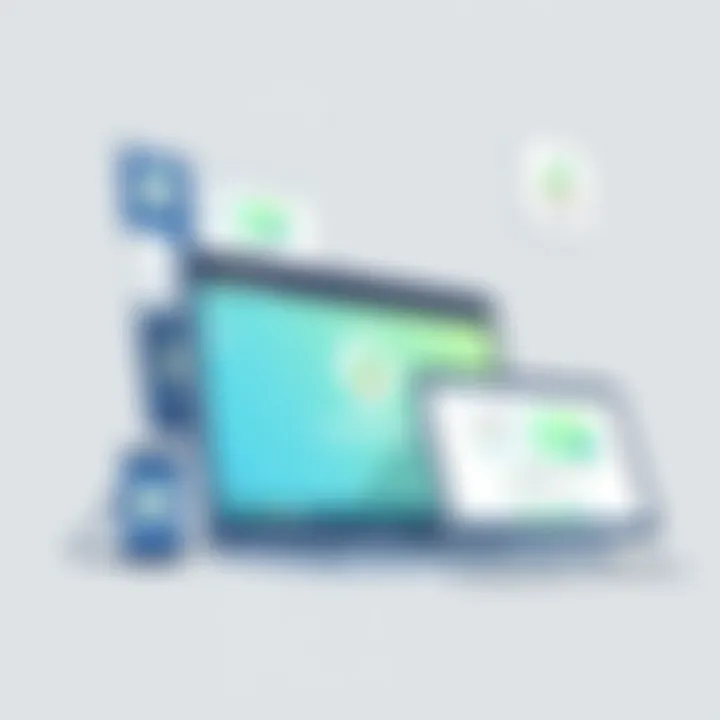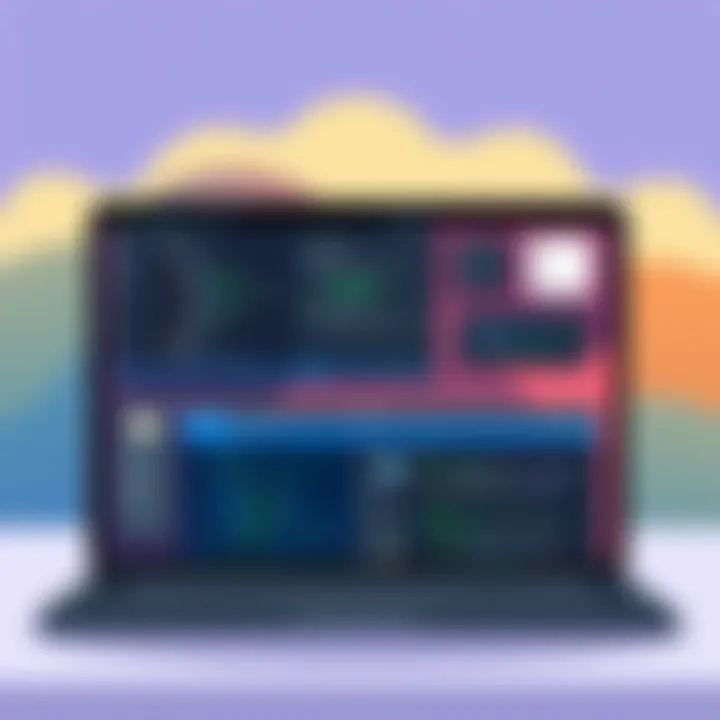Exploring Top Alternatives to Splashtop for Remote Access


Intro
In today's fast-paced business world, remote access tools have become essential for seamless collaboration. As organizations shift towards flexible work arrangements, finding reliable software to facilitate remote desktop capabilities is crucial. While Splashtop is a well-known player in this market, numerous alternatives exist. Each of these options brings its own strengths and shortcomings, making it necessary for IT professionals and business owners to thoroughly analyze them.
The following sections dive into key features, user experiences, and unique selling points that resonate with small to medium-sized businesses and entrepreneurs. Insights into pricing models and performance metrics will assist readers in making well-informed choices tailored to their operational needs. By examining these alternatives, the goal is to empower users with knowledge, helping them pinpoint software that aligns with their specific requirements.
Understanding Remote Access Software
Understanding remote access software is essential, especially for small to medium-sized businesses and IT professionals navigating the complexities of remote work. The increasing reliance on digital infrastructures means that having versatile tools for accessing remote systems can greatly impact operational efficiency. Remote access solutions allow users to connect to their computers or networks from nearly anywhere in the world. This flexibility not only supports workforce mobility but also ensures that productivity doesn't take a hit even when working away from the office.
Prologue to Remote Access Solutions
At its core, remote access software serves as a bridge, allowing users to connect to their home or office systems remotely. Consider a scenario where a technician needs to troubleshoot an issue at a client's site. Instead of making the trek back to the office, remote access software can let them resolve the problem from anywhere. This makes operations faster and often much more cost-effective.
Besides convenience, remote access solutions can also play a role in enhancing productivity. With tools that support file sharing and real-time collaboration, businesses can maintain seamless communication. Furthermore, security features in these solutions can safeguard sensitive data, addressing the frequent concern of data breaches in today's interconnected digital landscape.
Key Features of Remote Access Software
When evaluating remote access software, it's vital to consider the features that can best suit your business needs. Here are some key points to mull over:
- Ease of Use: A user-friendly interface is crucial. It saves time on training and enhances user adoption.
- Cross-Platform Compatibility: Whether your team uses Windows, Mac, or mobile devices, compatibility across platforms ensures everyone can stay connected.
- Security Protocols: High-level encryption, two-factor authentication, and robust access controls are non-negotiable features to protect your data.
- Performance Metrics: Low latency and high-speed connections can significantly influence remote access efficiency. You want a solution that doesn't feel like pulling teeth, causing frustrating delays.
- Support and Maintenance: Reliable customer service can be the difference between solving an issue in minutes versus spending hours in a quagmire of technical difficulties.
"The flexibility to work remotely is no longer a luxury but a fundamental necessity for modern businesses."
Importance of Choosing the Right Solution
Selecting the appropriate remote access solution is akin to choosing the right tool for a job; the wrong decision can lead to inefficiencies, security breaches, and ultimately frustration amongst users. Key considerations include your business’s specific needs, the type of data being accessed, and your budget constraints.
The stakes are particularly high for sectors dealing with sensitive information, such as finance or healthcare. Here, compliance with industry standards is crucial, adding another layer to the decision-making process. Additionally, understanding the scalability of your chosen solution is vital. As your business grows, your remote access needs may evolve, and flexibility can be a game-changer.
In summary, grasping the nuances of remote access software isn't just a technical requirement; it’s a strategic necessity that can drive efficiency and security for your organization.
Overview of Splashtop
Splashtop has carved a notable niche in the remote access software market. This platform is tailored for various users, including businesses needing efficient remote support and individual users seeking connectivity solutions. Understanding Splashtop’s architecture, benefits, and operational nuances is essential for anyone considering an alternative. Not only does it help in comparing other remote access solutions, but it also sheds light on what users typically expect from such tools.
The main draw of Splashtop lies in its versatility. Whether it's for IT support, remote work, or accessing files, it has something to offer. Businesses often seek tools that enhance efficiency and productivity. Splashtop emphasizes performance, with a focus on stability and ease of use.
By analyzing this platform, one gains insight into the fundamental expectations from remote access solutions and helps set benchmarks for alternatives.
Core Features of Splashtop
Splashtop packs a punch with its core features that cater to diverse user needs. Here’s a look at some key functionalities:
- Remote Desktop Access: Users can access their computers from anywhere, ensuring seamless connectivity.
- Multi-Device Support: It operates smoothly across several devices including Windows, macOS, iOS, and Android.
- File Transfer Capabilities: Easy file management allows users to transfer documents without fuss.
- High-Quality Streaming: The software is built to deliver a smooth streaming experience with minimal lag, making it ideal for resource-intensive tasks.
Splashtop's ability to integrate with other tools also adds to its attractiveness. This edge could make or break the user experience, and many appreciate the compatibility with customer support systems and workforce management apps.
Pricing Structure
When it comes to pricing, Splashtop’s model is designed with options that cater to various consumers, from individuals to enterprise-level businesses. Here are some components of its pricing structure:
- Subscription Plans: Users can choose monthly or annual subscriptions, allowing for flexibility.
- Tiered Pricing Options: Different pricing tiers exist based on features and users, which can accommodate varying business sizes and needs.
- Free Trial: A free trial version gives potential buyers a glimpse of what to expect without financial commitment.
This array of choices makes Splashtop accessible but is also a crucial element when compared to alternatives. It’s essential to know what you get for what you pay, as features vary significantly across platforms.
User Experience and Performance
User experiences with Splashtop tend to vary between individual cases, but there are common threads that surface in user feedback:
- Seamless Connectivity: Users often praise the stability and reliability when accessing systems remotely.
- Interface Navigation: The interface is user-friendly, but some advanced features might have a slight learning curve for first-time users.
- Customer Support: Although many find the support satisfactory, others have noted delays in response times during peak hours.
Performance-wise, users benefit from robust streaming capabilities, which can be crucial for tasks requiring real-time feedback, like gaming or graphic design. Overall, Splashtop manages to strike a balance between functionality and user experience, forming a solid foundation for any comparative analysis with other remote access solutions.
Identifying Key Alternatives


Identifying alternatives to Splashtop is a crucial endeavor for businesses looking to enhance their remote access capabilities. With the landscape of remote desktop software growing ever more diverse, it’s essential to go beyond the surface and understand what other options might offer. A thorough evaluation ensures that a company selects a software solution tailored to its specific needs, maximizing both efficiency and cost-effectiveness.
When businesses prioritize identifying alternatives, they embark on a journey that allows them to compare various tools’ functionality, pricing, and performance metrics. It highlights both the strengths and potential drawbacks of each option, enabling a well-rounded decision-making process.
Criteria for Evaluating Alternatives
In assessing different remote access solutions, it’s essential to consider several key criteria:
- Usability: The ease of use can impact the overall user experience. A clear and intuitive interface can reduce training time for employees.
- Platform Compatibility: Not all remote solutions work seamlessly across different operating systems. Find a solution that fits your organization's tech ecosystem, whether it's Windows, Mac, or Linux.
- Security Features: Data protection is paramount. Look for solutions that offer robust security protocols such as end-to-end encryption and multi-factor authentication.
- Performance Metrics: Evaluate how well each software performs during real-world use. Factors such as connection speed and reliability are pivotal.
- Support and Resources: Reliable customer service and available resources make problem resolution much easier. Evaluate if the vendor provides sufficient documentation and support channels.
- Pricing Models: Finally, it’s worth noting how payment structures align with your budget. Some solutions may offer flexible pricing, which can be beneficial for small to medium-sized businesses.
Comparative Analysis of Popular Alternatives
The market hosts a variety of alternatives to Splashtop, each boasting distinct features tailored for different users. Below is a comparative analysis of some popular options:
- TeamViewer: Renowned for its robust capabilities including instant remote support, it excels in cross-platform support. However, businesses may find its pricing on the steeper side for larger teams.
- AnyDesk: Known for its lightweight installation and low latency performance, AnyDesk is often favored for personal use and small businesses due to its cost-effectiveness, but it may lack some advanced features found in more comprehensive solutions.
- LogMeIn: Appreciated for its extensive feature set, including file transfer and remote printing options. Nevertheless, it tends to be pricier, which could be a consideration for a new startup.
- Chrome Remote Desktop: The simplicity and integration with Google services make it appealing, particularly for organizations already using those tools. However, it lacks some advanced features that professional users may require.
Evaluating these alternatives through the lens of the criteria mentioned earlier allows businesses to come away with a clearer picture of their best options. In doing so, they can tailor their choice of remote access solution to fit their specific operational needs.
TeamViewer as an Alternative
When searching for remote access solutions, TeamViewer stands out as a notable contender. This software has carved out a reputation for ease of use and robust functionality. Understanding TeamViewer's capabilities can help small to medium-sized businesses, entrepreneurs, and IT professionals make informed decisions about their remote desktop software options. In a world where remote work is becoming the norm, selecting the right tool is vital for efficiency and productivity. Below, we delve into TeamViewer's features, weigh its advantages against possible downsides, and share insights from users to paint a complete picture of what this application offers.
Feature Highlights of TeamViewer
TeamViewer is packed with features that cater to a broad range of remote access needs. Here are some highlights worth mentioning:
- Cross-Platform Compatibility: TeamViewer operates seamlessly across various platforms, be it Windows, Mac, Linux, or mobile devices. This ensures that users can connect to their systems from virtually anywhere, at any time.
- Remote Control and Desktop Sharing: Users can control devices remotely with ease. It allows for real-time collaboration, making it an excellent choice for teams working together from different locations.
- File Transfer: The ability to transfer files effortlessly between devices is vital for businesses. TeamViewer simplifies this process; just a few clicks and files are on their way without any hassle.
- Session Recording: For quality assurance and training purposes, TeamViewer enables session recording. This ensures that user interactions can be reviewed later, helping to refine processes and improve customer service.
- Robust Security Features: Security is a concern for many, especially when accessing sensitive information remotely. TeamViewer employs end-to-end encryption and two-factor authentication to safeguard data.
Advantages and Disadvantages
While TeamViewer offers a compelling suite of features, it is important to weigh its pros and cons before making an investment.
Advantages:
- User-Friendly Interface: Its intuitive design makes it accessible for new users, eliminating the steep learning curve often associated with such applications.
- Strong Support Options: TeamViewer provides extensive documentation, along with a proactive support team ready to assist users when they encounter issues.
- Scalability: As a business grows, its remote access needs might change. TeamViewer offers various subscription tiers, making it easier to scale up or down as necessary.
Disadvantages:
- Cost: TeamViewer's pricing may not be suitable for all businesses. Its subscription model can become pricey, especially for smaller organizations.
- Internet Dependency: Like many remote access solutions, a stable internet connection is necessary for optimal performance. Connection drops can disrupt workflow considerably.
User Feedback and Performance Review
Feedback from users offers crucial insights into the performance of TeamViewer. According to many reviews:
"TeamViewer has transformed how my team collaborates. The ease of remote access means we can work efficiently, even from different continents."
- A small business owner
Many users appreciate the software’s reliability, often highlighting its ability to handle multiple connections without significant lags. However, some users express frustration regarding the pricing structure, especially those who use it infrequently and feel they are paying for features they do not utilize fully.
In performance reviews, TeamViewer consistently receives high marks for its connectivity and speed. Nevertheless, occasional complaints about customer support response times imply that improvements could be made in addressing user issues more promptly.
TeamViewer's combination of features, usability, and real-world performance solidifies its position as a strong alternative to Splashtop, especially for those prioritizing secure and effective remote collaboration.
AnyDesk: A Viable Option
In the search for effective remote access solutions, AnyDesk emerges as a strong contender. Its ability to deliver reliable and high-quality connections positions it as a favorable alternative, particularly for small to medium-sized businesses as well as IT professionals. Understanding AnyDesk not only highlights its specific advantages and features but also illustrates why it's a relevant choice amidst its competition.
Unique Features of AnyDesk
AnyDesk stands out with a collection of innovative features that cater to diverse user needs. Some of its unique attributes include:
- DeskRT Codec: This proprietary technology guarantees high-quality transmission of audio and video, ensuring smooth operation even under limited bandwidth. This is crucial for users who need to sustain interaction without a hitch.
- Cross-Platform Support: AnyDesk is designed to work seamlessly across multiple platforms including Windows, macOS, Linux, and mobile operating systems like iOS and Android. This flexibility allows users to connect to their devices from anywhere, anytime.
- Remote Printing: Users have the ability to print documents from a remote device to a local printer, which can greatly enhance productivity for businesses operating in varied locations.
- Session Recording and Playback: This feature aids in documentation and training, allows users to review sessions later, ensuring that nothing important slips through the cracks.
These elements make AnyDesk a robust tool for businesses that require versatility and efficiency in their remote access software.
Cost-Effectiveness Analysis
When it comes to the budget, AnyDesk stands out as a cost-effective solution. Their pricing structure is designed to accommodate different business needs without breaking the bank:


- Free Version: Ideal for personal use or small projects, the free tier provides basic access, making it accessible for individuals or freelancers.
- Subscription Plans: The paid plans are reasonably priced, offering various tiers based on the number of devices managed and additional functionalities required. This graduated approach allows businesses to scale their usage according to growth.
- Return on Investment (ROI): By significantly reducing costs associated with travel and on-site services, users can achieve notable savings over time. Investing in AnyDesk not only enhances productivity but also results in lower operational costs overall.
Performance Comparison with Splashtop
When putting AnyDesk side-by-side with Splashtop, several comparisons surface that highlight its strengths:
- Connection Stability: Many users report experiencing fewer disconnections with AnyDesk compared to Splashtop, which can be pivotal during critical work sessions.
- Latency: AnyDesk demonstrates lower latency rates, especially when using its DeskRT codec, leading to faster response times that enhance the overall user experience.
- User Feedback: Reviews consistently point toward a more intuitive interface with AnyDesk, allowing users to jump into tasks with little onboarding time.
Overall, while both platforms offer quality remote access solutions, AnyDesk often shines, especially in fluctuating network environments, where its technology excels.
"Choosing the right remote access software can shape how efficiently your team collaborates, and AnyDesk delivers on that promise."
LogMeIn for Remote Control
When considering tools for remote access, LogMeIn often comes up as a robust option. For businesses, especially small to medium-sized ones, having a reliable remote control solution is crucial in today's work environment. LogMeIn provides a suite of features that enhance productivity, aid in remote troubleshooting, and support seamless collaboration among teams. Whether you’re managing a remote workforce or maintaining server configurations, LogMeIn makes it easier and safer.
Overview of LogMeIn Features
LogMeIn is packed full of features that cater to various needs of users engaged in remote operations. Key features include:
- Remote Desktop Access: Provides users with the ability to access their computers from anywhere, perfect for on-the-go work.
- File Transfer: Makes it easy to transfer files easily between your device and the remote computer. Users can access necessary files without any hassle.
- Multi-Monitor Support: Allows users to manage multiple monitors remotely, enhancing accessibility and organization.
- Integrated Messaging: Facilitates communication between remote users, thus reducing the need for external communication tools.
- Session Recording: Handy feature for businesses to monitor operations, especially in customer support scenarios.
- Security Features: Offers end-to-end encryption and two-factor authentication to ensure secure connections.
While most features sound appealing, the effectiveness varies based on business needs and how extensively the software is utilized.
Pros and Cons
When evaluating LogMeIn, it’s essential to weigh both the advantages and downsides:
Pros:
- User-Friendly Interface: Even those less tech-savvy can navigate it easily, making it an accessible choice for various users.
- Strong Security Protocols: With increasing concerns about data breaches, LogMeIn’s focus on security is a significant plus.
- Regular Updates: Keeps the software fresh and tackles emerging security threats.
Cons:
- Pricing Concerns: Some users find it relatively more expensive compared to other options like Chrome Remote Desktop or TeamViewer.
- Limited Free Version: The free version of LogMeIn lacks many features which may deter businesses just starting out.
- Dependency on Internet Speed: Performance can falter if the internet connection isn't stable, affecting the remote experience.
"Choosing the right remote access software is not just about features but also about how it aligns with your workflow and budget."
User Reviews and Insights
Feedback from users often highlights both the strengths and weaknesses of LogMeIn. Many appreciate its reliability and ease of use, particularly for remote teams. Some reviews note that it performs well in scenarios where smooth operation is a must, such as IT support or project management.
On platforms like Reddit, some users argue:
- "For straightforward access, it does the job well, but if you're looking for extensive remote management capabilities, there may be better alternatives out there."
- Others express dissatisfaction over the cost, highlighting that while the features are solid, they wish there were more competitive pricing models available.
For instance, according to feedback on forums, users frequently express that although LogMeIn is beneficial for ongoing projects, they feel alternatives often provide similar features at lower costs.
In summary, with LogMeIn, businesses can expect a dependable remote access solution. However, understanding one's specific needs and budget constraints is vital in determining whether it is the right match.
Chrome Remote Desktop
In the discussion of remote access solutions, Chrome Remote Desktop emerges as a noteworthy alternative to Splashtop. Its significance lies in its straightforward integration with existing Google services, making it highly accessible to those already within that ecosystem. Given the ever-evolving work environment, where collaboration can occur anywhere, understanding what Chrome Remote Desktop offers in terms of functionality, ease of use, and practical application is essential for small to medium-sized businesses, entrepreneurs, and IT professionals.
Benefits of Chrome Remote Desktop
One primary draw of Chrome Remote Desktop is its zero-cost structure, which presents a lucrative opportunity for startups or businesses operating on tight budgets. This option doesn't skimp on the essentials necessary for remote access. Key benefits include:
- Cross-platform Compatibility: Works seamlessly across various operating systems—be it Windows, Mac, or Linux—broadening its utility.
- Simple Setup: A user-friendly interface ensures swift installation and minimal technical know-how is required.
- Secure Connection: Utilizing Google's robust infrastructure, it employs secure protocols to safeguard user data during sessions.
Furthermore, the convenience of accessing Chrome Remote Desktop from any device that can run the Google Chrome browser enhances its attractiveness.
Limitations and Considerations
However, while Chrome Remote Desktop is robust, it is not without its drawbacks. Potential users should keep several limitations in mind:
- Limited Features: It lacks some advanced features found in premium services, like file transfer capabilities or remote printing.
- Dependent on Chrome: Again, a good solution for users of the Chrome ecosystem; however, those preferring other browsers might find it cumbersome.
- Connection Stability: Users have reported occasional connectivity issues, which can prove disruptive.


Before settling on Chrome Remote Desktop as a solution, evaluating these limitations against specific needs can ensure that expectations align with reality.
Ideal Use Cases
Chrome Remote Desktop shines in several scenarios, particularly for smaller operations. Here are some ideal use cases:
- Remote IT Support: Technicians can quickly access clients' computers for troubleshooting without the need for complex configurations.
- Accessing Work Computers: Professionals needing to reach their work systems from home or while traveling can do so easily, maintaining workflow without the awkward VPN setups.
- Collaborative Projects: Teams working on shared tasks can utilize Chrome Remote Desktop to share screens, enhancing collaboration without requiring additional software.
In the end, Chrome Remote Desktop fills a niche for those seeking a cost-effective, simple, and reliable way to manage remote access, especially aligned with other Google tools.
Despite its limitations, the ease of access and steady performance of Chrome Remote Desktop make it a viable candidate for remote access tasks.
For further insights, consider these resources:
Comparative Evaluation of Alternatives
In the world of remote access software, simply picking a name and running with it can often lead to decisions you'll regret later. This is where a Comparative Evaluation of Alternatives strikes a chord. It empowers business owners and IT professionals to sift through the mountain of options available. Using a systematic approach ensures you grasp the nuanced differences between platforms that might otherwise appear quite similar at first glance. With remote work setups becoming more common, the stakes are high: efficiency, cost-effectiveness, and security are just a few factors that can influence the bottom line.
To truly capitalize on what remote access software can offer, consideration of each alternative’s specific strengths and weaknesses is pivotal. Evaluating options side by side allows stakeholders to make more informed choices and align with their operational needs.
Feature Set Comparison
When creating a shortlist of potential remote desktop solutions, comparing feature sets is often the first step. Each software comes packed with different functionalities—ranging from file transfer capabilities, multi-platform support, to session recording options. This comparison shines the light on what’s actually useful. For example, while one solution may offer superior file transfer speeds, it might lack adequate security measures. Others may present robust collaboration features but could be overpriced for what they ultimately deliver.
Main features worth considering include:
- Cross-platform compatibility (Windows, Mac, Linux, mobile devices)
- Ease of use (user interface and accessibility)
- Collaborative tools (chat functions, shared whiteboards, etc.)
- Security protocols (encryption, two-factor authentication)
A detailed analysis not only helps to highlight the unique aspects of each alternative but also assists in forming a balanced judgment about which software might best meet your organization's requirements.
Price Comparison Overview
Cost is undeniably a crucial factor in any business decision. A straightforward price comparison provides clarity and can dramatically influence the final choice of software. Pricing structures can vary considerably across products—some may be subscription-based, while others might offer one-time purchases. Hidden costs can lurk as well, such as fees for additional users or features, which can catch decision-makers off guard down the line.
When comparing prices, consider the following elements:
- Initial cost vs. long-term investment (monthly vs. yearly payments)
- Availability of free trials or tiered pricing models that can help tailor solutions based on needs
- Support and maintenance fees
- Discounts for small to medium-sized businesses
Understanding the overall financial impact of each alternative typically results in better value for investment.
Performance Metrics in Real-World Scenarios
Performance is the true test of remote access software, particularly under real-world conditions where network environments can fluctuate. To assess performance effectively, metrics such as connection speed, latency, and overall reliability during peak usage times are essential. Looking at how these alternatives perform in different scenarios can prepare you for the unpredictable nature of remote work.
Compare benchmarks like:
- Time taken to establish connections
- Quality of video and audio streaming during sessions
- General speed of file transfers and sharing
- Impact on system performance (CPU usage, bandwidth consumption)
Gathering data from real-world usage can often help in making a rational decision rather than relying on marketing claims or user reviews alone. Evaluating alternatives from a performance standpoint can prove critical in keeping your operations running smoothly.
"Failing to compare must-haves and nice-to-haves can lead businesses to waste budgeting on subpar solutions."
In summary, a thorough comparative evaluation of remote access alternatives not only illuminates the strengths and weaknesses of each platform but also brings crucial financial and performance considerations to the forefront. This approach fosters smarter decisions tailored to meet specific business needs.
Culmination
The conversation surrounding remote access solutions can often feel like a double-edged sword; while the myriad options available promise flexibility and connectivity, narrowing down the selection to find the right fit is no small feat. This article has dissected several alternatives to Splashtop, each with unique offerings that can cater to varying organizational needs. We’ve highlighted features, pricing, and performance, which are critical to making informed decisions that align with individual business priorities.
Summary of Findings
- Robust Alternatives Exist: We explored multiple software solutions like TeamViewer, AnyDesk, LogMeIn, and Chrome Remote Desktop, each exhibiting distinct strengths that can appeal to different user requirements. TeamViewer thrives in feature-rich environments, while AnyDesk excels in cost-effectiveness and performance.
- Critical Comparisons: The comparative evaluation of features played a key role in understanding how each alternative stacks up against the others. For instance, while chrome Remote Desktop is reliable for casual users, professional environments may demand the comprehensive approach provided by solutions like LogMeIn.
- Performance Metrics Matter: In real-world scenarios, the practical performance of these tools can differ significantly. As noted in user feedback, the connection quality and ease of access are paramount, influencing overall satisfaction and efficiency.
- Consider Pricing Wisely: Pricing models also vary greatly; some software offers flexible licensing structures while others lock users into annual contracts. Analyzing the cost alongside feature sets is vital for aligning budget constraints with organizational needs.
The findings from this analysis foster clarity in a landscape cluttered with choices, enabling businesses to select the appropriate remote access software solutions that can enhance productivity and workflow.
Recommendations for Business Applications
When selecting a remote desktop solution, here are some key recommendations to consider:
- Identify Specific Needs: Different teams have varying requirements. IT professionals may prioritize security and features, while staff members may lean towards ease of use and reliability.
- Cost vs. Features: Balance what you are willing to invest against the features that you need. A more expensive option like TeamViewer might offer extensive functionalities, but simpler solutions like AnyDesk can suffice for basic tasks at a lower cost.
- Trial Periods: Make good use of trial periods to assess software compatibility with existing workflows and technology stack. User experience during trial can shed light on software reliability and performance.
- Long-Term Scalability: Choose solutions that not only fit your current needs but also allow for future growth. As businesses expand, a solution that can adapt to increased demands can save future headaches.
In summary, the decision-making process should involve comprehensive research and an understanding of how each software platform aligns with your company's specific needs. This way, you are not just choosing a tool; you are investing in a pathway to greater efficiency and operational excellence.



